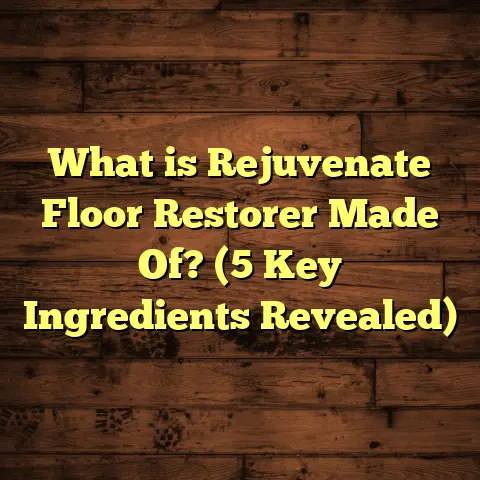What is Commercial Grade Laminate Flooring? (5 Key Benefits Revealed)
Did you know that the commercial flooring market is expected to grow by nearly 7% annually over the next five years? This growth reflects a rising demand for flooring options that combine durability, aesthetics, and cost-effectiveness in commercial environments. If you’re considering flooring solutions for your business or commercial property, you might have come across terms like “commercial grade laminate flooring.” You may wonder what exactly it means, what makes it different from regular laminate flooring, and whether it’s a good fit for your needs. I’ve worked with numerous clients over the years, installing and advising on commercial flooring projects, so I want to share what I’ve learned about this versatile material — along with some stories and insights from my own experience.
What Is Commercial Grade Laminate Flooring?
When people hear “laminate flooring,” they often think of a budget-friendly alternative to hardwood. But commercial grade laminate flooring is more than just “laminate.” It’s a specially engineered product designed to withstand the demands of business spaces with high foot traffic, heavy equipment movement, and frequent cleaning.
To break it down: laminate flooring consists of multiple layers fused together. The topmost layer is a “wear layer” that provides scratch and stain resistance. Beneath that is a photographic design layer that replicates the appearance of natural wood or stone. The core layer — typically made of high-density fiberboard (HDF) — gives the plank strength and stability. Lastly, there’s a backing layer that prevents moisture damage and adds balance.
Commercial grade laminate takes these components up a notch:
- Thicker and tougher wear layers — often rated AC3 to AC5 for abrasion resistance.
- Denser core materials that resist dents and warping.
- Moisture-resistant features to handle spills and humidity.
- Enhanced UV protection to prevent fading in sunlit areas.
Where regular laminate may be fine for a home with moderate foot traffic, commercial grade laminate is built to last in places like retail stores, restaurants, medical clinics, office lobbies, schools, and hotels.
The Abrasion Class (AC) Rating System
One of the most important things I always explain to clients is the AC rating system. It’s a standardized measure of how well laminate flooring resists wear:
- AC1: Suitable for light residential use (bedrooms).
- AC2: Moderate residential use (living rooms).
- AC3: Heavy residential or light commercial use (small offices).
- AC4: General commercial use (retail stores, cafes).
- AC5: Heavy commercial use (airports, supermarkets).
For commercial projects, I rarely recommend anything below AC4 because it won’t stand up to the daily wear and tear. For areas with even heavier traffic or rolling loads like carts, AC5 is ideal.
Why Does Core Density Matter?
I’ve seen cases where cheaper laminates had low-density cores that compressed or swelled after a short time, causing gaps or uneven surfaces. High-density fiberboard cores resist these issues better. They also make the floor feel more solid underfoot.
In one project for a busy medical office, we chose a laminate with an HDF core rated for moisture resistance. Even after years of wet mop cleaning and occasional spills, the floor stayed intact and smooth.
Appearance Without Compromise
Modern printing technology lets commercial laminates realistically mimic all kinds of natural materials — from rustic reclaimed wood to polished marble. This means businesses don’t have to sacrifice style for durability.
For example, I worked with a boutique hotel that wanted the look of dark walnut hardwood but needed a surface that could survive luggage wheels and heavy housekeeping traffic. We selected a commercial laminate with an authentic wood grain pattern and deep finish that still looked great years later.
5 Key Benefits of Commercial Grade Laminate Flooring
Based on my years installing and maintaining commercial floors, here are five reasons why this option stands out:
1. Durability That Stands Up to Heavy Traffic
If you own or manage a business space, you know how relentless foot traffic can be. People coming in and out all day can quickly wear down ordinary floors. Commercial grade laminate is designed specifically to handle this kind of abuse.
I remember one retail client who was skeptical at first because their previous wooden floor showed scratches within months. After installing AC5-rated commercial laminate, they called me after two years just to say how surprised they were by how little wear was visible despite thousands of daily customers.
This durability comes mainly from the aluminum oxide wear layer on top. It’s like a shield that protects the decorative surface underneath from scratches, stains, impacts, and scuffs.
A few numbers to consider:
- AC4 or AC5 laminates can withstand over 12,000 rotations on the Taber Abrasion Test — one of the strictest durability tests.
- Compared to hardwood floors which may dent under heavy loads or sharp heels, commercial laminates resist dents better due to their hard top coating.
2. Cost-Effective Without Sacrificing Style
Commercial laminate flooring is one of the most budget-friendly options out there when you factor in both material and installation costs.
In one office renovation I managed recently, the client initially considered engineered hardwood for the entire 3,000 sq ft space. When I showed them comparable commercial grade laminate options with realistic wood visuals, they saved about 30% on upfront costs.
Installation was faster too — saving labor expenses — which meant less downtime during their office move-in.
Here’s a quick cost breakdown:
| Flooring Type | Material Cost (per sq ft) | Installation Cost (per sq ft) | Total Estimated Cost (per sq ft) |
|---|---|---|---|
| Commercial Laminate | $2 – $5 | $1 – $3 | $3 – $8 |
| Hardwood Flooring | $5 – $15 | $3 – $6 | $8 – $21 |
| Vinyl Flooring | $1.50 – $4 | $1 – $2 | $2.50 – $6 |
Besides price, laminate offers nearly limitless design options from natural woods like oak and maple to exotic finishes like slate or travertine stone.
3. Faster Installation Means Less Business Disruption
One question I always get: “How long will the flooring take?” For busy commercial settings where downtime equals lost revenue, speed matters a lot.
Commercial laminates often come with click-lock installation systems. This allows installers like me to lay planks quickly without glue or nails — reducing mess and cleanup time.
In my experience:
- For a typical 2,000 sq ft office space: laminate can be installed in about 2-3 days.
- Tile installation can take double that time due to mortar drying and grout curing.
- Hardwood installations usually require sanding and finishing onsite that may add more days.
I’ve worked on multiple projects where quick installation helped businesses reopen faster—something owners deeply appreciated.
Also, floating floors (laminate over underlayment) don’t require major subfloor prep like some other floorings do — another time saver.
4. Low Maintenance Saves Time and Money
Keeping floors looking great in commercial spaces needs efficient cleaning routines. Commercial laminate flooring makes this easy.
I tell clients:
- Sweep or vacuum daily to remove dirt and grit that cause scratches.
- Mop weekly using a damp mop with laminate-safe cleaner diluted in water.
- Wipe spills immediately to prevent staining.
- Avoid excessive water which can seep into seams over time.
Unlike hardwood floors that need polishing or waxing periodically, laminate requires little more than routine cleaning.
One café owner I worked with was thrilled when their floor stayed spotless despite daily coffee spills and food crumbs. Their cleaning staff found it simple to maintain without special products or equipment.
5. Moisture & UV Resistance Protects Floor Appearance
Moisture can be a killer for many floor types—causing swelling, warping, or staining. Commercial grade laminates are made with moisture-resistant cores and waterproof coatings that reduce these risks.
In healthcare facilities where cleanliness is paramount and mopping is frequent, this resistance prolongs floor life dramatically. It also makes laminate suitable for restaurants where spills are common.
UV protection built into the wear layer helps prevent fading in sun-exposed areas like storefront windows or lobby entrances.
In one sunny retail store project I handled, the floor color remained vibrant after years despite large glass windows letting in direct sunlight all day long.
How To Select The Right Commercial Grade Laminate Flooring For Your Project
Choosing the right commercial laminate isn’t just about picking a pretty pattern. Here are some factors I always review with clients:
Consider Your Foot Traffic Levels
The busier your space, the higher AC rating you’ll want. For example:
- Small offices or boutiques: AC3 or AC4 could be enough.
- Large retail stores or airports: AC5 or above recommended.
Check Thickness And Core Material
Typical thickness ranges from 7mm to 12mm or more. Thicker planks feel more solid but cost more. For heavy commercial use, I recommend 8mm minimum with HDF cores for strength.
Look For Moisture Resistance Features
If your location has humidity issues or frequent spills (cafes/restaurants), pick laminates with moisture-resistant cores and sealants on edges.
Choose Complementary Underlayment
Adding underlayment improves sound absorption—important for offices—and adds comfort underfoot. Some underlayments also add vapor barriers protecting from subfloor moisture.
Match Aesthetic To Brand Identity
Your floor says a lot about your business personality. Whether you want rustic warmth or sleek modern looks, pick designs that reflect your brand and appeal to customers/workers alike.
Installation Insights: What Can Go Wrong And How To Avoid It
I’ve seen both smooth installs and some tricky ones over my career. Here’s what I’ve learned about common pitfalls:
Subfloor Preparation Is Critical
Uneven or dirty subfloors cause uneven planks or squeaky floors later on. Always spend time leveling floors before laying laminate.
Acclimate Flooring Materials
Let planks sit in the installation area for 48 hours at room temperature before installation so they adjust properly to humidity and temperature changes.
Leave Expansion Gaps
Laminate expands/contracts slightly with climate changes. Always leave small gaps (usually 1/4 inch) around walls or obstacles to prevent buckling later.
Avoid Water Exposure During Installation
Don’t install over wet subfloors or use excessive water during cleaning right after installation; this can cause damage or swelling.
Hire Professionals For Large Projects
While DIY is possible for small residential areas, commercial projects benefit from professional installers who understand building codes, warranties, and logistics.
Maintaining Your Commercial Grade Laminate Flooring Over Time
A well-maintained floor lasts longer and keeps your space looking professional:
- Daily sweeping/vacuuming prevents grit damage.
- Weekly damp mopping removes surface dirt.
- Immediate cleanup of spills prevents stains.
- Use protective pads under furniture legs.
- Replace damaged planks quickly to avoid spread of damage.
- Schedule annual inspections by pros if possible.
Stories From The Field: Real-Life Experiences With Commercial Grade Laminate
I want to share some experiences from my work because real stories help bring facts alive better than dry stats:
Story #1: The Medical Clinic
A local clinic needed durable floors that could handle constant foot traffic plus frequent cleaning with disinfectants. We installed high-grade commercial laminate with moisture-resistant core and extra UV protection under bright lights.
After 4 years, the floor looked almost brand new despite daily cleanings including bleach solutions. The clinic manager told me it was one of their best facility investments ever because it combined hygiene with style effortlessly.
Story #2: Retail Storefront
A fashion boutique wanted luxury hardwood visuals but feared scratches from customers trying on shoes and heavy shopping bags being dropped occasionally.
We chose an AC5-rated laminate with deep wood grain embossing that hid minor wear well. The owner called after two years amazed that no visible scratches had appeared despite thousands of customers walking through weekly.
Story #3: Restaurant Flooring
Restaurants face spills and grease regularly – not ideal for many floors. We installed commercial laminate designed specifically for wet environments with extra sealed edges.
The kitchen staff appreciated how easy it was to clean at closing time each night without worrying about damage or discoloration from spills.
Comparing Commercial Grade Laminate To Other Popular Commercial Flooring Options
It helps to see how commercial laminate stacks up against other choices:
| Feature | Commercial Laminate | Hardwood | Vinyl | Carpet | Tile |
|---|---|---|---|---|---|
| Durability | High (AC4/AC5) | Moderate | Moderate-High | Low | Very High |
| Cost | Moderate | High | Low | Low | Moderate |
| Installation Time | Fast | Slow | Fast | Fast | Slow |
| Maintenance | Low | Moderate | Low | High | Moderate |
| Appearance Variety | Wide | Limited by species | Wide | Wide | Moderate |
| Moisture Resistance | Moderate-High | Low | High | Low | High |
Frequently Asked Questions About Commercial Grade Laminate Flooring
Q: Can commercial grade laminate handle rolling chairs?
A: Yes! Especially if it has an AC4 or AC5 rating paired with a dense core, it can withstand rolling office chairs without denting easily.
Q: Is it safe for healthcare environments?
A: Absolutely — many healthcare providers use commercial laminate because it’s easy to clean and resists chemicals used in disinfectants.
Q: How long does it usually last?
A: With proper maintenance, you can expect 10+ years in most commercial settings before replacement might be necessary.
Q: Can I install it over existing flooring?
A: Often yes — as long as the existing floor is level and stable (like vinyl or tile). This saves removal costs and reduces installation time.
Wrapping Up My Thoughts On Commercial Grade Laminate Flooring
After working on dozens of projects across industries — offices, retail stores, clinics, restaurants — I’ve seen firsthand that commercial grade laminate flooring holds up well under pressure while offering appealing design options at reasonable costs.
It’s a smart choice if you want durable floors that look great without expensive upkeep or long installation times. Of course, selecting the right product based on traffic levels and environment is key — but once that’s done right, this flooring won’t let you down.
If you’re planning your next commercial flooring project and want personalized advice or help estimating costs based on your location and preferences, tools like FloorTally can make budgeting easier by providing local material/labor rates combined with customizable design options.
Got specific questions about your space? Just ask! I’m happy to share more insights from my work so you can feel confident about your flooring choice.
Thanks for reading along!
If you want me to expand any particular section further or add more case studies or technical details, just let me know!





